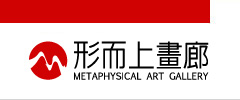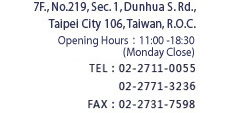|
 |
|
| |
 |
 |
 |
| |
¡@¡@As an artist, Zhong Biao
adheres to "visualization" to accomplish
his "archeological work." Instead of
juxtaposing concepts, he expresses himself through
paradoxical scenes. While his early works usually
juxtapose cultural images of different times,
his later works are characterized by more transformation.
He sets color dimension against time direction.
Those aged images are infused with colors by the
artist, yet the images close to our daily life
are deprived of any color and scenery. Lively
men lose color, yet the color in dresses and accessories
they wear, symbols of the era, remain. As the
colors fade away, the limit between reality and
memory diminishes and illusion begins. This illusion,
rather than being founded on pure biological sensation,
as in the case of surrealism, is based on cultural
accumulation and memory.
¡@¡@If the surrealist style
is but a crisis of self-identity reflected in
the rapid industrialization of earlier times,
then Zhong Biao's works appear to have initiated
a "new surrealist style." This style
embodies an individual's doubt about his own knowledge. |
|
 |
| |
|
¡@¡@Zhong Biao's unique work approach demonstrates
that his cultural attitude is entirely different
from that of previous artists. Be it political
bop or gaudy art, what they were eager to put
across was their own attitudes, criticizing either
ideology or commercial culture. Zhong Biao seems
to keep distance from this sort of criticism.
In his works we find calmness unique to intellectuals.
What he broods over is not how to criticize, but
where our evidence for criticism comes from and
how their meanings have undergone changes. Zhong
Biao's contemplation over China's pop culture
and mass culture, we find a new cultural attitude.
It is unlike artists concerned with pop culture
who either mix their works with real pop culture
under the pretext of a particular concept or criticize
mass production of pop culture as artists defend
old handcraft. It is possible that art based on
handwork and individual production is not a match
to real mass culture and its media.
¡@¡@The relationship
between art that criticizes mass culture, in the
name of art and mass culture itself is more like
that between a fly bat and a big fly. In Zhong
Biao's works, we can see through the setting of
illusions and the incompletion in the images that
he gives up not only the antagonistic relations
between art and mass culture, but also the attempt
to control mass culture. Ultimately he finds,
through "visualization," a space for
art in a place where there is no influence of
mass culture. |
|
| |
|
| |
|
 |
|
| 1968 |
Born in Chongqing. |
| 1991 |
BFA. The Oil Painting
Department of China Academy of Fine Arts
Associate Professor, Sichuan Fine Arts Institute.
Associate Director, Chongqing Art Museum. |
| |
|
| Solo Exhibitions
- |
| 1996 |
The Fable of life, Arts
Museum of Sichuan Fine Arts Academy ,Chongqing. |
| 1997 |
The Fable of life, Schoeni
Art Gallery, Hong Kong. |
| 2001 |
A Chance Existence, Art
Scene China Gallery, Hong Kong. |
| 2004 |
Zhong Biao, Benamou Gallery,
Paris, France.
Ubiquity, Art Scene Warehouse, Shanghai. |
| |
|
| Group Exhibitions
- |
| 1990 |
The Second Chinese Sport
Art Exhibition. China Art Museum, Beijing. |
| 1991 |
Chinese Oil Painting Exhibition,
Tokyo, Japan. |
| 1993 |
The First Chinese Oil
Painting Bi-Annual Exhibition, China Art Museum,
Beijing. |
| 1995 |
Taipei Art Fair ( TAF'95
),Taipei World Trade Center, Taipei Taiwan.
History of Contemporary Chinese Oil Painting-From
Realism to Post-Modernism, Galerie Theoremes,
Brussels, Belgium.
Vision of China -Contemporary Paintings by
Chinese Masters, Pacific City Club, Bangkok
, Thailand. |
| 1996 |
Eleven's-The Avant-garde,
Taikoo Place, Hong Kong.
Art Miami'96, Miami Beach Convention Center,
Miami, U.S.A. |
| 1998 |
Asian Avant-garde, Christie's
London, England. |
| 1999 |
As Beautiful as Materialism-Chinese
New Concept Art Exhibition, Shanghai.
The Northeast (Korea, China, Japan) and the
Third World Art Exhibition,
Seoul Art Museum, Korea.
Joint Exhibition of Chinese-Vietnamese Oil
Paintings, Asia Artist Gallery, Singapore. |
| 2000 |
At The New Century,1979-1999
China Contemporary Art's Works, Chengdu.
Contemporary Art Gallery, Chengdu.
Chinese museum Chinese walls, Groningen, Holland. |
| 2001 |
China Art Now! Singapore
Art Museum, Singapore.
Chinese Contemporary Art Exhibition of Painting,
Elsalvador,Sao Paulo,Brazil.
.Chilis from Chongqing, Kulturbahnhof Kassel,
Germany.
Next Generation-Art Contemporary of Asia,Passage
de Petz,Paris,France.
Lust for Life, Galerie Piltzer, Paris,France. |
| 2002 |
Art Miami'2002, Miami
Beach Convention Center, Miami, U.S.A.
Chicago International Art Exposition, Chicago,
U.S.A.
Let's go, Chinese Contemporary Artists with
the Football World Cup, China Millennium Monument,
Beijing.
Chinese Contemporary Art Exhibition of Painting,
National Museum of Art, Peru.
Chinese Contemporary Art Exhibition of Painting,
Mexico Post Palace, Mexico.
Chinese Contemporary Art Exhibition of Painting,
Museum of Art Contemporary, Damascus, chile.
Foison-Contemporary Art Exhibition of China,
China Agriculture Exhibition Center, Beijing,
China. |
| 2003 |
Chicago International
Art Exposition, Chicago,U.S.A.
The Album of The First Beijing International
Art Biennale, Beijing
Third China National Exhibition of Oil Paintings,
China Art Museum ,Beijing.
The First Beijing International Art Biennale.
China 2003-Showpiece Contributed by the Teachers
at the Ten China's Art Schools (Academic Award),Tsinghua
University Art Museum, Beijing.
International Contemporary Drawing Art, Xi'an
Guangzhou.
Department-Contemporary Art Exhibition, Mountain
White Pagoda, Hangzhou.
Image of Image, Shenzhen Art Museum, Shenzhen. |
| 2004 |
FIAC,Paris,France.
In Between----The Contemporary Oil Painting
Exhibition ,Tang Gallery, Bangkok Thailand.
Forbidden Senses----Sensuality in Contemporary
Chinese Art, Presentee en Dordogene a l'Espace
Culturel francois Mitterrand de Perigueux
et a l'Ancien Eveche de Sarlat,France.
China Contemporary Art, Indonesia.
Asian Art Invitational Exhibition, Frey Norris
Gallery, San Francisco, California, USA.
Chinese Contemporary Art Exhibition, Kunstbunker,Munich,
Germany. |
| |
|
| Awards |
|
| 2004 |
The Tenth National Exhibition
of China Arts, Guangdong Art Museum, Guangdong.
The First Nominative of Fine Arts Literature
(Literature Award),Art Museum of Hubei Fine
Art Academy, Hubei. |
|
|
|
| |
|
|







